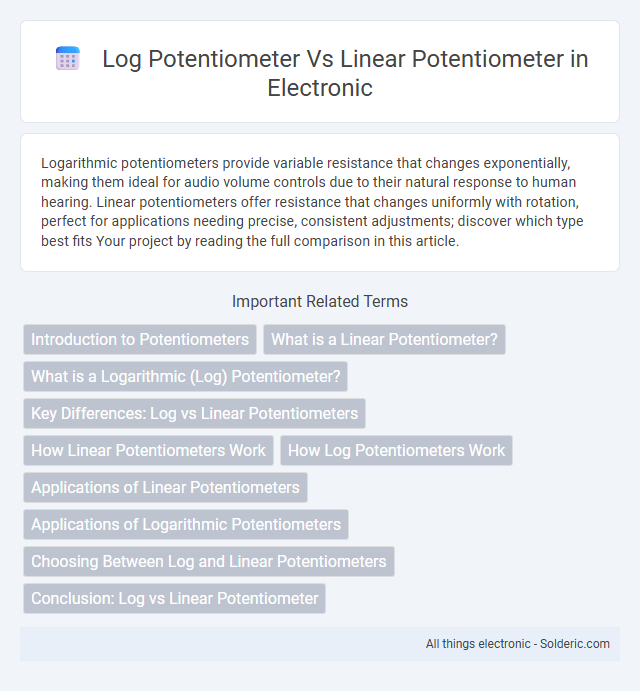Logarithmic potentiometers provide variable resistance that changes exponentially, making them ideal for audio volume controls due to their natural response to human hearing. Linear potentiometers offer resistance that changes uniformly with rotation, perfect for applications needing precise, consistent adjustments; discover which type best fits Your project by reading the full comparison in this article.
Comparison Table
| Feature | Logarithmic (Log) Potentiometer | Linear Potentiometer |
|---|---|---|
| Resistance Change | Changes logarithmically relative to the shaft position | Changes linearly relative to the shaft position |
| Common Use | Audio volume controls, tone controls | Position sensing, adjustable power supplies |
| Response Curve | Non-linear, better matches human hearing | Linear, proportional adjustment |
| Sensitivity | Higher sensitivity at low-end adjustments | Uniform sensitivity across full range |
| Applications | Audio engineering, sound equipment | Measurement instruments, control circuits |
| Cost | Typically higher due to complex taper | Generally lower cost |
Introduction to Potentiometers
Potentiometers are variable resistors used to adjust voltage levels in electronic circuits, with log and linear types serving distinct functions. Linear potentiometers change resistance at a constant rate, making them ideal for precise control applications like volume sliders. Logarithmic potentiometers vary resistance logarithmically, matching the human ear's perception of sound, which is essential for audio volume control.
What is a Linear Potentiometer?
A linear potentiometer provides resistance that changes uniformly along its track, making it ideal for applications requiring precise, proportional voltage adjustments. Unlike a log potentiometer, which varies resistance logarithmically to match human hearing, a linear potentiometer offers predictable, consistent control useful in sensors and measurement devices. Your choice between linear and log potentiometers depends on whether you need even electrical response or audio-tapered control.
What is a Logarithmic (Log) Potentiometer?
A logarithmic (log) potentiometer is an adjustable resistor designed to vary resistance in a way that corresponds to a logarithmic scale, matching the human ear's perception of sound intensity. This type is commonly used in audio applications such as volume controls to provide a more natural and gradual increase or decrease in audio level. Unlike linear potentiometers, which change resistance uniformly, log potentiometers offer resistance changes that exponentially align with audio signal adjustments.
Key Differences: Log vs Linear Potentiometers
Log potentiometers have a nonlinear resistance curve that matches the logarithmic response of human hearing, making them ideal for audio volume control. Linear potentiometers provide a constant rate of resistance change, suited for precise adjustments in electronic circuits and sensor applications. Your choice between log and linear potentiometers depends on whether you need smooth volume ramps or uniform control in your device.
How Linear Potentiometers Work
Linear potentiometers function by varying resistance in a direct proportional manner as the slider moves along a resistive track, enabling precise voltage division. This allows the output voltage to change linearly relative to the position of the wiper, ideal for applications requiring accurate and consistent control signals. Their straightforward resistance-to-position relationship makes them preferred in volume controls and sensor input devices needing predictable response curves.
How Log Potentiometers Work
Log potentiometers operate by varying resistance in a nonlinear, logarithmic manner, aligning with the human ear's perception of sound intensity, making them ideal for audio volume controls. The resistive element is designed so that the change in output voltage corresponds to the logarithm of the knob's rotation angle, allowing smoother and more natural volume adjustments. Unlike linear potentiometers, which change resistance proportionally, log pots provide finer control at lower levels and coarser control at higher levels, enhancing audio user experience.
Applications of Linear Potentiometers
Linear potentiometers are commonly used in applications requiring precise voltage division and straightforward position sensing, such as volume controls in audio equipment and light dimmers. They excel in environments where a uniform resistance change is essential, providing more predictable and linear output for calibration instruments and industrial controls. Your projects benefit from linear potentiometers when consistent and proportional feedback is crucial for accurate adjustments.
Applications of Logarithmic Potentiometers
Logarithmic potentiometers are primarily used in audio equipment for volume control, as their resistance changes mimic the human ear's logarithmic response to sound intensity. These potentiometers enable smooth and natural sound level adjustments, making them essential in professional audio mixers, guitar amplifiers, and radios. Unlike linear potentiometers, which change resistance at a constant rate and are suited for general voltage division tasks, log potentiometers handle audio signal variations more effectively.
Choosing Between Log and Linear Potentiometers
Choosing between log and linear potentiometers depends on your application's signal response requirements, where log potentiometers provide a nonlinear resistance change suited for audio volume control, matching human hearing perception. Linear potentiometers offer a uniform resistance increase, making them ideal for precise control adjustments in measurement and instrumentation. Understanding your device's input sensitivity helps you select the potentiometer that ensures accurate and smooth operation.
Conclusion: Log vs Linear Potentiometer
Logarithmic potentiometers provide variable resistance that matches the human ear's perception of sound, making them ideal for audio volume controls. Linear potentiometers offer uniform resistance changes, suitable for applications requiring precise adjustments such as position sensing or signal conditioning. Choosing between log and linear potentiometers depends on whether the task demands natural audio scaling or consistent, proportional input variation.
log potentiometer vs linear potentiometer Infographic

 solderic.com
solderic.com